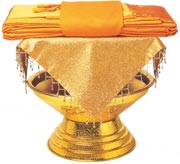 |
The Pali word kathina refers to a wooden frame on which Buddhist monks in ancient India used to stretch and sew the cast-off scraps of cloth that made up their robes. Today Kathina robes are made of new cloth, but in honour of tradition they are constructed from fourteen separate patches.
The period between the full moon in October and the full moon in November is considered the “month of the robe”, a time when Buddhists in the Theravada tradition can gain spiritual merit by donating robes and other necessities to the monks in their local temple.
The Kathina festival takes place at the end of the Vassa, or three months retreat. During this period the monks have been sequestered in their monastery; at the end of this time many will resume the life of a wandering mendicant. This makes it a particularly appropriate time for the ceremonial presentation of the Kathina robes. Only those monks who have completed the entire retreat are entitled to receive the new vestments.